1997 PONTIAC GRAND AM torque
[x] Cancel search: torquePage 85 of 371
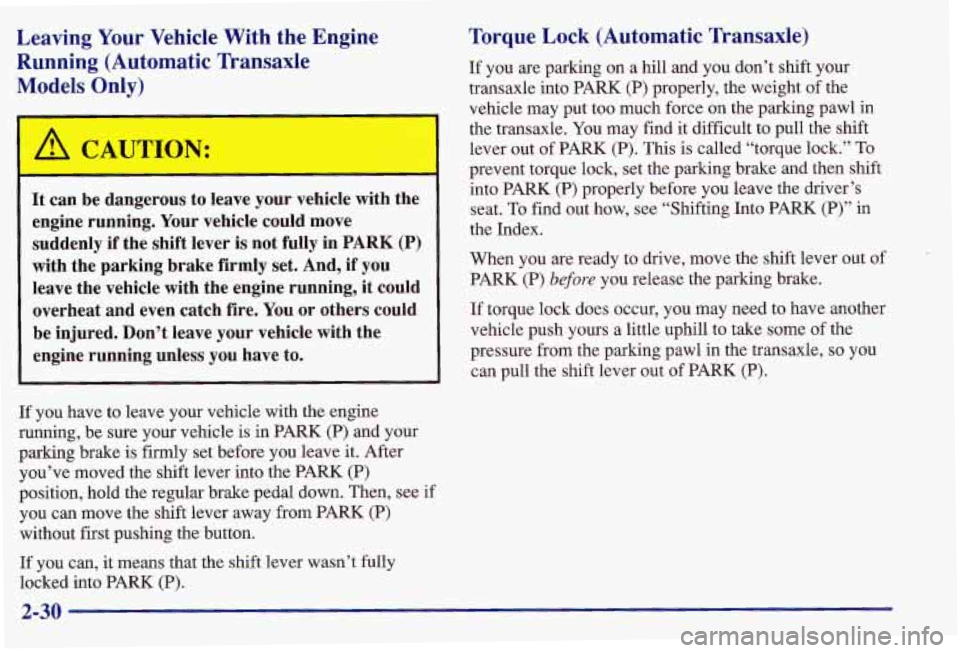
Leaving Your Vehicle With the Engine
Running (Automatic Transaxle
Models Only)
A CAUTION:
I
I
It can be dangerous to leave your vehicle with the
engine running. Your vehicle could move
suddenly if the shift lever is not fully in
PARK (P)
with the parking brake firmly set. And, if you
leave the vehicle with the engine running,
it could
overheat and even catch fire.
You or others could
be injured. Don’t leave your vehicle with the
engine running unless you have to.
If you have to leave your vehicle with the engine
running, be sure your vehicle is in PARK (P) and your
parking brake is firmly set before you leave it. After
you’ve moved the shift lever into the PARK
(P)
position, hold the regular brake pedal down. Then, see if
you can move the shift lever away from PARK (P)
without first pushing the button.
If you can,
it means that the shift lever wasn’t fully
locked into PARK (P).
Torque Lock (Automatic Transaxle)
If you are parking on a hill and you don’t shift your
transaxle into PARK
(P) properly, the weight of the
vehicle may put too much force on the parking pawl in
the transaxle. You may find it difficult to pull the shift
lever out of PARK (P). This is called “torque lock.”
To
prevent torque lock, set the parking brake and then shift
into PARK
(P) properly before you leave the driver’s
seat.
To find out how, see “Shifting Into PARK (P)” in
the Index.
When you
are ready to drive, move the shift lever out of
PARK (P)
before you release the parking brake.
If torque lock does occur, you may need to have another
vehicle push yours a little uphill to take some of the
pressure from the parking pawl in the transaxle, so you
can pull the shift lever out of PARK
(P).
2-30
Page 222 of 371
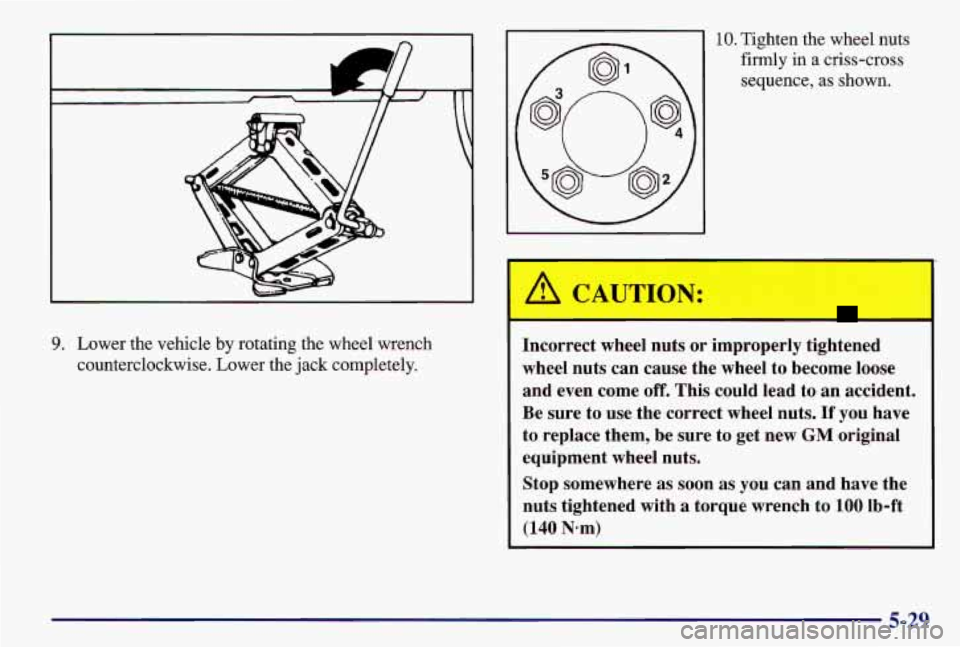
9. Lower the vehicle by rotating the wheel wrench
counterclockwise. Lower the jack completely.
10. Tighten the wheel nuts
firmly in a criss-cross
sequence,
as shown.
Incorrect wheel nuts or improperly tightened
wheel nuts can cause the wheel to become loose
and even come
off. This could lead to an accident.
Be sure to use the correct wheel nuts.
If you have
to replace them, be sure to get new
GM original
equipment wheel nuts.
Stop somewhere
as soon as you can and have the
nuts tightened with
a torque wrench to 100 lb-ft
(140 N-m)
5-29
Page 223 of 371
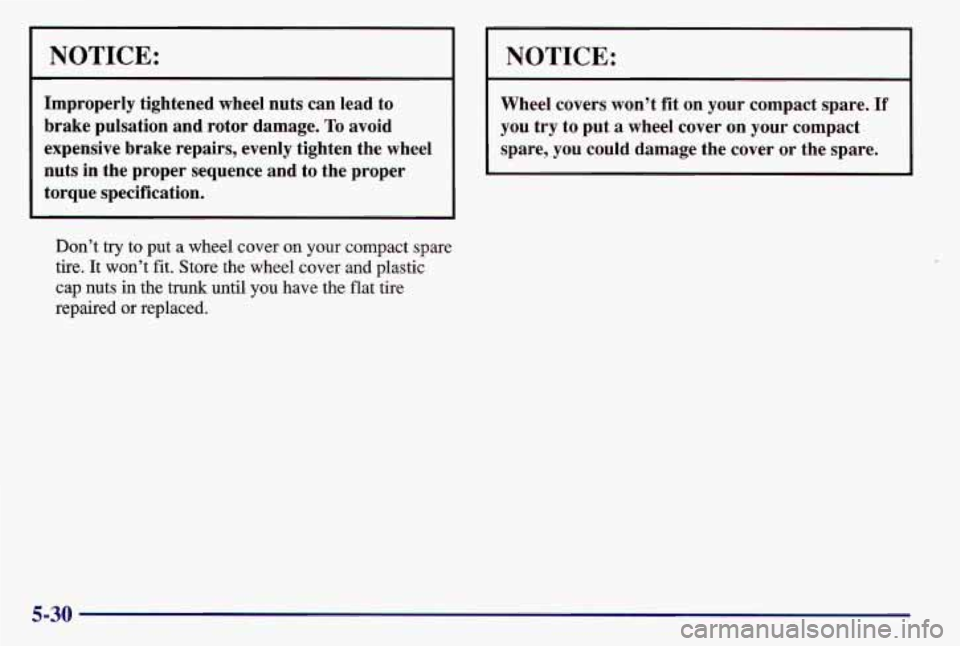
NOTICE:
Improperly tightened wheel nuts can lead to
brake pulsation and rotor damage.
To avoid
expensive brake repairs, evenly tighten the wheel
nuts in the proper sequence and to the proper
torque specification.
Don’t try to put a wheel cover on your compact
spare
tire. It won’t fit. Store the wheel cover and plastic
cap nuts in the
trunk until you have the flat tire
repaired
or replaced.
NOTICE:
Wheel covers won’t fit on your compact spare. If
you try to put a wheel cover on your compact
spare, you could damage the cover or the spare.
5-30
Page 260 of 371
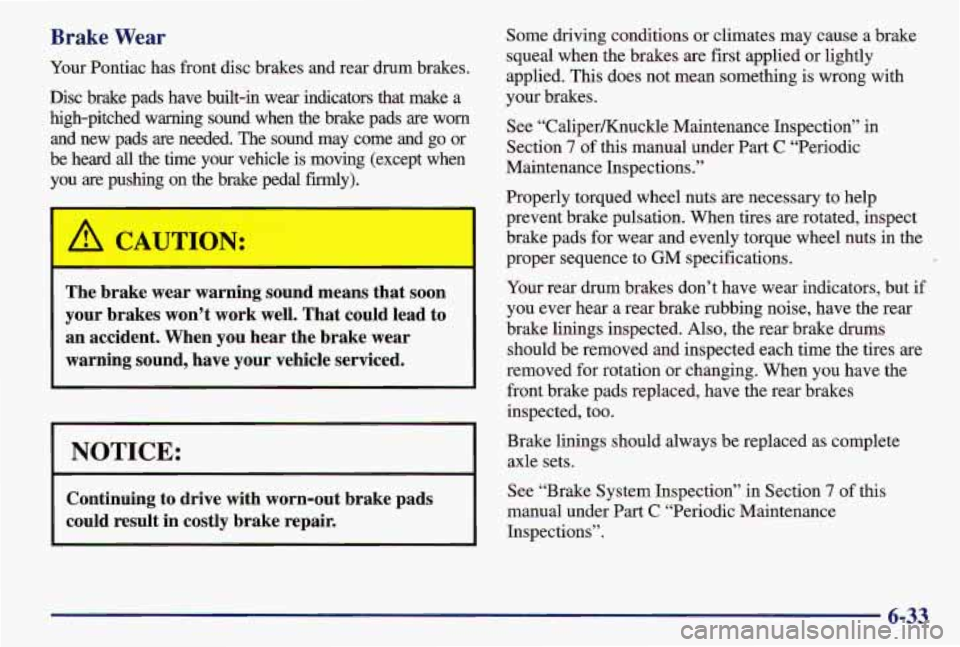
Brake Wear
Your Pontiac has front disc brakes and rear drum brakes.
Disc brake pads have built-in wear indicators that make a high-pitched warning sound when the brake pads are worn
and new pads are needed. The
sound may come and go or
be heard all the time your vehicle is moving (except when
you are pushing on the brake pedal
firmly).
The brake wear warning sound means that soon
your brakes won’t work well. That could lead to
an accident. When you hear the brake wear
warning sound, have your vehicle serviced.
I NOTICE:
Continuing to drive with worn-out brake pads
could result in costly brake repair.
Some driving conditions or climates may cause a brake
squeal when the brakes are first applied or lightly
applied. This does not mean something is wrong with
your brakes.
See “Caliper/Knuckle Maintenance Inspection” in
Section
7 of this manual under Part C “Periodic
Maintenance Inspections.”
Properly torqued wheel nuts are necessary to help
prevent brake pulsation. When tires
are rotated, inspect
brake pads for wear and evenly torque wheel nuts in the
proper sequence to
GM specifications.
Your rear drum brakes don’t have wear indicators, but if
you ever hear a rear brake rubbing noise, have the rear
brake linings inspected. Also, the rear brake drums
should be removed and inspected each time the tires are
removed for rotation or changing. When you have the
front brake pads replaced, have the rear brakes
inspected, too.
Brake linings should always be replaced as complete
axle sets.
See “Brake System Inspection” in Section
7 of this
manual under Part C “Periodic Maintenance
Inspections”.
6-33
Page 270 of 371
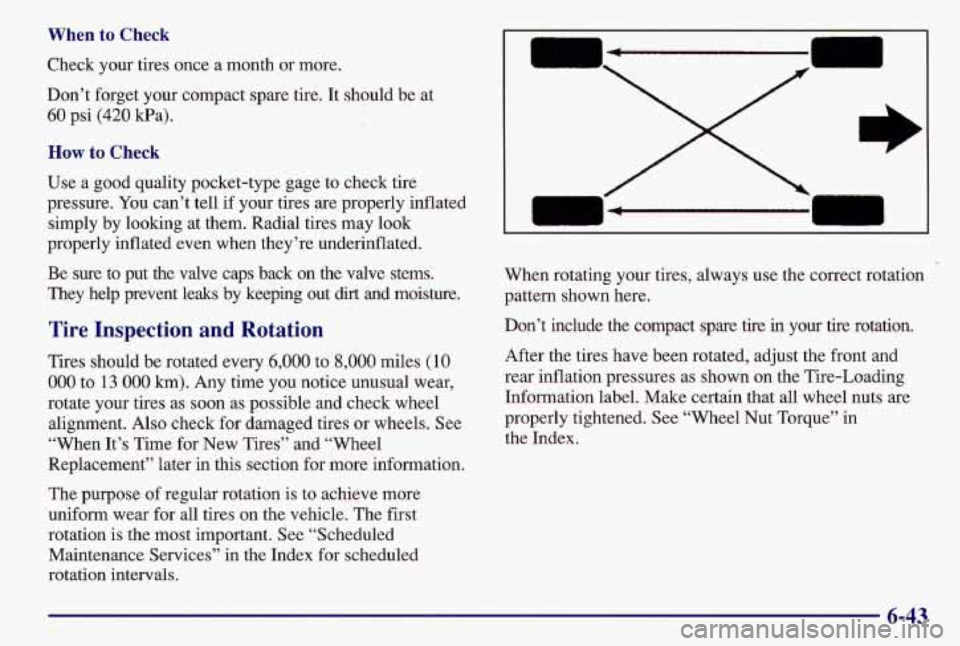
When to i- -- ~
Check your tires once a month or more.
Don’t forget your compact spare tire. It should be at
60 psi (420 Pa).
How to Check
Use a good quality pocket-type gage to check tire
pressure.
You can’t tell if your tires are properly inflated
simply by looking at them. Radial tires may look
properly inflated even when they’re underinflated.
Be sure to put the valve caps back on the valve stems.
.They help prevent leaks by keeping out dirt and moisture.
Tire Inspection and Rotation
Tires should be rotated every 6,000 to 8,000 miles (10
000 to 13 000 km). Any time you notice unusual wear,
rotate your tires as soon as possible and check wheel
alignment. Also check for damaged tires or wheels. See
“When It’s Time for New Tires” and “Wheel
Replacement” later in this section for more information.
The purpose of regular rotation
is to achieve more
uniform wear for all tires on the vehicle. The first
rotation is the most important. See “Scheduled
Maintenance Services’’ in the Index for scheduled
rotation intervals.
0
I
When rotating your tires, always use the correct rotation
pattern shown here.
Don’t include the compact spare tire
in your tire rotation.
After the tires have been rotated, adjust the front
and
rear inflation pressures as shown on the Tire-Loading
Information label. Make certain that all wheel nuts are
properly tightened. See “Wheel Nut Torque” in
the Index.
6-43
Page 291 of 371
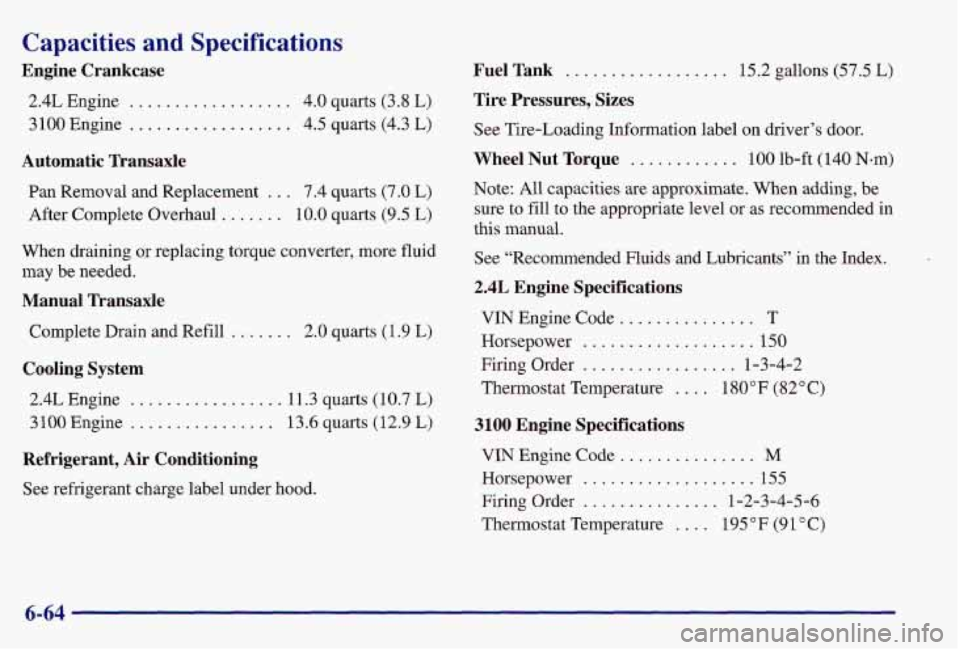
Capacities and Specifications
Engine Crankcase
2.4L Engine . . .......
3 100 Engine .............
. 4.0 quarts (3.8 L)
. 4.5 quarts (4.3 L)
Automatic Transaxle
Pan Removal and Replacement ... 7.4 quarts (7.0 L)
After Complete Overhaul
....... 10.0 quarts (9.5 L)
When draining or replacing torque converter, more fluid
may be needed.
Manual Transaxle
Complete Drain and Refill ....... 2.0 quarts (1.9 L)
Cooling System
2.4L Engine . .... ..... 11.3 quarts (10.7 L)
3100 Engine ................ 13.6 quarts (12.9 L)
Refrigerant, Air Conditioning
See refrigerant charge label under hood.
Fuel Tank .........
Tire Pressures, Sizes
....... 15.2 gallons (57.5 L)
See Tire-Loading Information label on driver’s door.
Wheel Nut Torque ............ 100 lb-ft (140 Nem)
Note: All capacities are approximate. When adding, be
sure to fill to the appropriate level
or as recommended in
this manual.
See “Recommended Fluids and Lubricants” in the Index.
2.4L Engine Specifications
VIN Engine Code ........ __. T
Horsepower ................. 150
Firing Order ................. 1-3-4-2
Thermostat Temperature
.... 180°F (82 O C)
3100 Engine Specifications
VIN Engine Code ........ ... M
Horsepower ..... ... 155
Firing Order
............... 1-2-3-4-5-6
Thermostat Temperature
. . 195°F (91°C)
6-64
Page 368 of 371
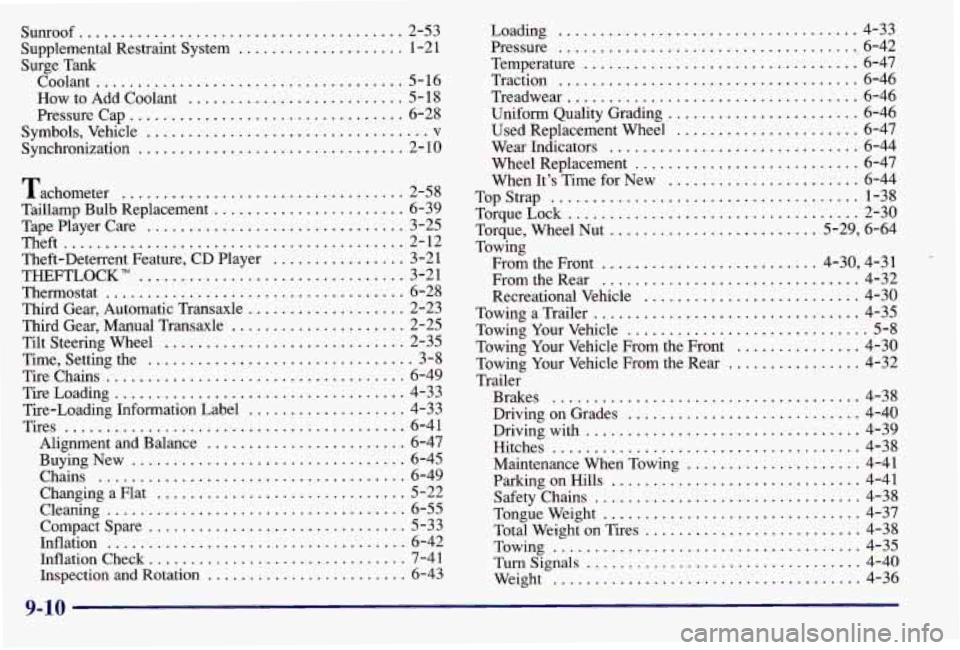
Sunroof ................................... 2-53
Supplemental Restraint System
.................... 1-21
Surge Tank
Coolant
..................................... 5- 16
How to Add Coolant
.......................... 5- 18
Pressure Cap
................................. 6-28
Synchronization
.......... ........ ... 2-10
Symbols. Vehicle
....... .................... v
Tachometer
.................................. 2-58
Taillamp Bulb Replacement
....................... 6-39
TapePlayerCare
............................... 3-25
Theft
......................................... 2-12
Theft-Deterrent Feature, CD Player
................ 3 -2 1
THEFTLOCK
TM ................................ 3-21
Thermostat
.................................... 6-28
Third Gear, Automatic Transaxle
................... 2-23
Third Gear, Manual Transaxle
..................... 2-25
Tilt Steering Wheel
............................. 2-35
Time, Setting the
................................ 3-8
Tire Chains
.................................... 6-49
TireLoading
................................... 4-33
Tire-Loading Information Label
................... 4-33
Tires
......................................... 6-41
Alignment and Balance
........................ 6-47
Chains
..................................... 6-49
BuyingNew
................................. 6-45
ChangingaFlat
.............................. 5-22
Cleaning
.................................... 6-55
Compact Spare
............................... 5-33
Inflation
.................................... 6-42
Inflation Check
............................... 7-41
Inspection
and Rotation ........................ 6-43 Loading
.............................. 4-33
Pressure
..................................... 6-42
Temperature
................................. 6-47
Traction
.................................... 6-46
Treadwear
................................... 6-46
Uniform Quality Grading
....................... 6-46
Used Replacement Wheel
...................... 6-47
Wear Indicators
.............................. 6-44
Wheel Replacement
........................... 6-47
When It’s Time for New
....................... 6-44
TopStrap
..................................... 1-38
TorqueLock
................................... 2-30
Torque, Wheel Nut
......................... 5-29, 6-64
Towing From the Front
.......................... 4-30, 4-31
From the Rear
............................... 4-32
Recreational Vehicle
.......................... 4-30
Towing a Trailer
................................ 4-35
Towing Your Vehicle
............................. 5-8
Towing Your Vehicle From the Front
............... 4-30
Towing Your Vehicle From the Rear
................ 4-32
Trailer
Brakes
..................................... 4-38
Driving on Grades
............................ 4-40
Hitches
..................................... 4-38
Maintenance When Towing
..................... 4-41
Parking on Hills
.............................. 4-41
Safety Chains
................................ 4-38
Tongueweight
............................... 4-37
Total Weight on Tires
.......................... 4-38
Towing
..................................... 4-35
Turnsignals
................................. 4-40
Weight ..................................... 4-36
Drivingwith
................................. 4-39
9-10
Page 369 of 371

Transaxle Automatic
.................. 2.16.2.21.6.19. 7.42
Manual
...................... 2.16.2.25.6.21. 7.42
Transmitters. Keyless Entry
........................ 2-7
Transportation. Courtesy
.......................... 8-8
Trir, Odometer ................... .......... 2-57
Trink Lamr,
........................ .......... 2-47 I
Lock ....................................... 2-10
Security Override ............................. 2- 1 1
Turn Signal and Lane Change Signals ............... 2-36
Turn Signal/Multifunction Lever
................... 2-35
Turn Signals When Towing a Trailer
................ 4-40
TTYUsers
..................................... 8-5
Underbody
Flushing Service ................. 7-44
Underbody Maintenance
......................... 6-56
Up Shift Light
.......................... 2-27, 2-69
variable Effort Steering
... ............... 4-11
Vehicle Control
.................................... 4-6
Identification Number
......................... 6-58
Storage
...................... .......... 6-34
Ventilation System
............................... 3-7
Visor Vanity Mirrors
............................ 2-52
Damagewarnings
.............................. iv
Dimensions
................................. 6-65
Loading
.................................... 4-33
Visors, Sun
.................................... 2-52 warning
Devices
............................. 5-2
Warning Lights. Gages and Indicators ............... 2-58
Warranty Information
.......................... 8-10
Washer Fluid. Windshield ...................... 6-29
Washing Your Vehicle
........................... 6-54
Weatherstrips
....... ............ ........... 6-53
Alignment
................................ 6-47
Nut Torque ............................. 5-29, 6-64
Replacement
................................. 6-47
Used Replacement
............................ 6-47
Wrench
..................................... 5-25
Windows
..................................... 2-34
Auto-Down
.................... ...... 2-34
Windshield Washer
............................. 2-38
Fluid Level Check
............................ 7-41
Windshield Wiper
.............................. 2-37
Blade Replacement
........................... 6-41
Winter Driving
................................. 4-26
Wiring, Headlamp
.............................. 6-59
Wrench, Wheel
........ ................ 5-25
Wheel
Lock
Out Switch ............................. 2-34 .
Power ....................................... 2-34
Fluid
.................................. 2-38, 6-29
Bladecheck
................................. 7-42
Fuses
...................................... 6-59
Wrecker Towing
........... ............... 5-8
9-11